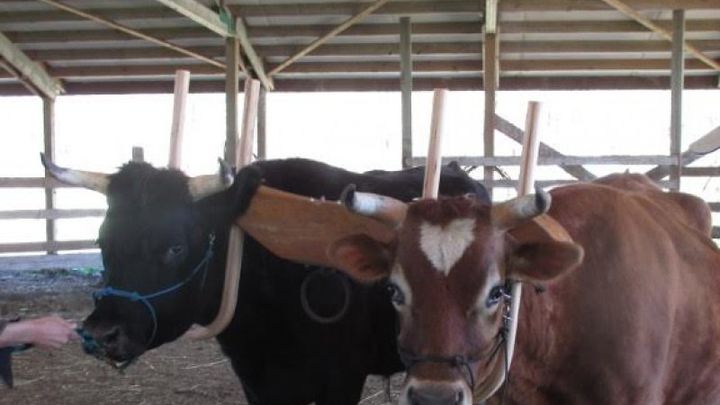
New Nandagram Project
Donation protected
Buying dairy products at the store has long made me feel guilty. After all, you don’t have to do much research to find out that dairy cows are exploited. Their babies are snatched away at birth, often before they have even had one sip of their momma’s milk. The cows are “retired” to a slaughter house the moment their production of milk doesn’t meet economic expectations. In spite of this unfortunate reality, more than 40 years after my sprirtual master Srila Prabhupada instructed his followers to protect cows and produce our own necessities, most of us still buy dairy products produced on commercial dairies.
My husband Billy and I weren’t thinking about getting a cow. We didn’t want to make the time and commitment it takes to care for a cow and the herd that results from breeding her. Our involvement with cows came when my daughter started dating a vegan and Benjy, a Buddhist, wanted to know how we morally justified eating dairy products when we knew full well that the dairies were immoral places. Of course I explained that the cow benefits when I offer her milk/yogurt/butter to Krsna. Benjy wasn’t convinced, and occasionally made comments about the immorality of the commercial dairies that kept the uneasiness that I felt when buying dairy products at the forefront of my consciousness.
Then one day I got a phone call from Val, a friend who manages a local educational facility where they teach about pioneer life here in the Pacific Northwest. Val: “we need someone to milk our cow for 3 and half months while the museum is closed for the winter. Would you be interested?” She explained that they keep a cow so that people who come to the museum can have a “hands on” experience of milking, but usually sell the cow in the fall and buy a new one in the spring. Everyone working at the museum really liked Rain, their current cow, so they decided to try to keep her milking. With visions of myself under the cow in 20 degree weather, milking with frozen hands, I agreed with trepidation.
A few weeks later Rain was in our barn and we immediately fell in love with her. Rain was a jersey with a relaxed and affectionate personality but who also loved to bounce around and attack the manure cart when I was cleaning her stall. She loved nothing better than a good, thorough scratch on her brisket and withers, and would reciprocate by licking us with her scratchy tongue. I quickly found that I enjoyed the peaceful time spent milking her. Milking a cow is a connection to a timeless activity and my life developed a rhythm that helped me be conscious of Krsna’s perfect design. Sitting on a hand made wooden stool as the sun is setting on a mild evening, singing bhajans to my cow as I rhythmically milk her into a stainless steel bucket, is a pleasure that few people have experienced. I discovered that it took more time to process, store and distribute the milk and dairy products than it took to milk and care for the cow.
Through numerous “experiements” often resulting in what came to be called “happenstance cheese” (appropriate for soup and casseroles),I eventually developed a nice quality cheese that I could make without having a lot of special equipment. My cheese press was a colander with weights from Billy’s barbells. The cheese is aged in the refrigerator. Soon I was hosting cheese making classes and introducing many people to the concept of cow protection.
As spring approached, Rain’s milk production slowed to the point that I was concerned whether Rain would benefit the museum without being bred. They needed a cow that gave enough milk so many children per day could learn how to pinch off the milk that entered the teat and then squeeze that milk into a pail. Having a new calf would replenish her milk supply, so I trailered Rain to a neighboring dairy and introduced her to the young, mostly white Holstein bull on duty. The following winter she gave birth to a feisty black heifer, Dhana, and the museum agreed that since we took care of breeding Rain that the resulting calf would be ours.
We did the math regarding breeding cows and concluded that if we breed a cow every 2 years and the lifespan of a cow/bull is 20 years, we’d have to care for a herd of 10 cows/bulls to keep a milk cow. We had three acres, which was much too small a property to keep 10 cows, so we began to hope to be able to move further into the country where property is more affordable. When we first desired to move, it wasn’t possible to relocate right away due to Billy’s job, so we decided to learn everything we could about living self reliantly.
With the help of a group of like-minded people who formed a group called The Self Reliant Community, we studied bees, seed saving, grain crop raising, alternative energy, food preserving, composting, herbal medicine, making oil from oil seeds, alternative currencies, permaculture and much more. I eventually began training our first bull calf, Makani and found it very satisfying to work with him.
In 2010 the company that Billy worked for eliminated the division that Billy worked in so he joined the ranks of the unemployed. At that time we had 3 cows; Dhana, the matriarch; Makani, her brother and Dhana’s first calf, Lani Moo. We realized that it was time to find a property that was suitable for keeping cows. Several years earlier, Billy, while I was experimenting with using hypnosis in conjunction with astrology had an out-of-body experience where he felt himself to be an eagle flying through a beautiful valley. He had an overwhelming feeling that the valley he was seeing was a safe place, a sanctuary. After that experience, we’d sometimes go for day trip adventures, trying to find the valley. We strongly felt that the Morton/Randle area was near that valley and we’d look at satellite maps, trying to pinpoint the exact location.
One day I decided to go look for properties in the area we were attracted to. Since I intended to explore vacant properties, and generally be nosy, I decided to take a friend and leave Billy home. He is uncomfortable knocking on strangers’ doors, driving down deserted driveways and doesn’t like people to think he is lurking or loitering. Good thing, too. The friend I brought as a spotter saw a property that looked vacant. We drove into the driveway and could immediately see that it was abandoned. Knee high grass was growing around the buildings, there were no vehicles or personal things around and some of the windows were boarded up. There was no “for sale” sign, but there was a paper in one of the windows with a name and phone number in very small type on it. So we noted the address and the phone number and I went home to research the property.
Searching the county records, the owner turned out to be the Veterans Administration, making us surmise that the property had been in foreclosure. Additionally there were over 15,000 sq. ft of buildings including two barns a covered arena and other out buildings. The house was 1200 sq. ft with a garage. When I called the phone number, a realtor answered and said, yes, it was for sale with an asking price of $84,000. I told her we were very interested and then convinced Billy to make an offer. For us, buying the property with neither of us working a job was like diving off a cliff without being sure that there was water to dive into. We decided to sell our house and if it sold before the new property closed escrow, the equity would pay for the new property. It was 2011, and the real estate market was terrible, so the odds of selling our house quickly were poor. Although we didn’t like the idea of renting it out, that would be our only option if it didn’t sell right away. Amazingly we had an offer within days of putting it up for sale, and a contract in escrow within a week. Even more amazing was that we were able to purchase the new property without having a mortgage. It was the first time in my adult life that I was debt-free. Billy had had that freedom before, and being of an older generation, he was back in his comfort zone.
Our new property was perfect for doing a cow project: it had a large barn with stalls, a huge covered area to serve as a goshalla, plenty of storage for hay and the most wonderful soil for growing grass to feed our growing herd. In fact it turned out to be sub-irrigated, meaning that we didn’t have to water our garden, and that the grass continues to grow throughout the dry season. There was only one drawback, and it was a major one: there were only five acres, not enough to support the growing herd. We had noticed that at the northeast corner of the property there was a gate to a neighboring parcel that was safely fenced with no barbed wire and a nice 24‘ x 24‘ run-in barn. I don’t like barbed wire because if an animal gets a foot caught in it he’s likely to be seriously injured. Ranchers use it because it is effective and affordable, but they aren’t protecting cows, they’re exploiting them. As soon as we got hooked up to the internet, we intended to find the owner of that pasture and see if we could lease it.
A couple of days after we had moved in, our realtor stopped by and was very excited. “How many acres did you buy here?” Karen asked. Billy replied, “it is 5 acres.” “Wrong! You got another parcel, a 9 acre pasture with a barn! I just found out!”
We dug out the deed we received when the property was transferred, and sure enough, under the property description it listed: lot A and lot B, with lot B being about 9 acres. Of course we considered this surprise to be a gift from Krsna showing His support of our project. Right now the cows are out on that green pasture, lying under a cedar tree, chewing their cuds.
Cow protection is not the job for one older couple. Billy was 69 when we moved here three years ago, and I was 53. Our financial resources are meager, just Billy‘s social security. Fences need to be maintained, hay put in for the winter, buildings maintained, poop scooped, compost piles turned and money is needed to buy feed for the winter. As the herd began to grow, we needed help. A quarter mile down the road, at the base of Dog Mountain, a favorite hang gliding site, is a group of properties that was sub-divided years ago into mostly five acre parcels. Amazingly Krsna has allowed loyal Prabhupada devotees to buy three of the five properties, with each devotee purchasing a property that he was uniquely able to buy. One couple needed to have owner financing with a low down payment. One devotee needed to buy a foreclosure that was priced for a quick cash sale and one devotee needed a beautiful retreat. Now we have devotee neighbors to help us with the cows.
Although we didn’t intentionally start a cow protection project, we feel that the fact that Krsna gave us the opportunity, and we took it, that He is pleased with what we’re doing. Some devotees seem to keep cows more as props for fund-raising and I’m sorry, I think that’s wrong. Rescuing a few cows from slaughter doesn’t change the perception many people have that cows are here for our enjoyment, not as a part of God’s plan for how people should live. Living an ideal lifestyle means that cows are important community members who contribute by their labor and products. The only way to demonstrate that cow protection is satisfying, economically feasible and pleasing to God is to develop a community that genuinely lives that lifestyle. We didn’t have a community, but apparently Krsna is sending one to us. At the same time, the farmers around us to see how much we enjoy our bovine community members and hopefully their hearts are a little softened. We have plans to include them and the Deities (the very first Deities of ISKCON, the Panca Tattva ) in a local Loggers Jubilee parade. We are in need of new equipment such as harnesses, yokes, a cow shoeing stall, and milking paraphernalia.
So for those of you who secretly believe that it isn’t possible to protect cows, just look at what Krsna has done here to help an older, financially challenged couple try to fulfill Srila Prabhupada’s vision.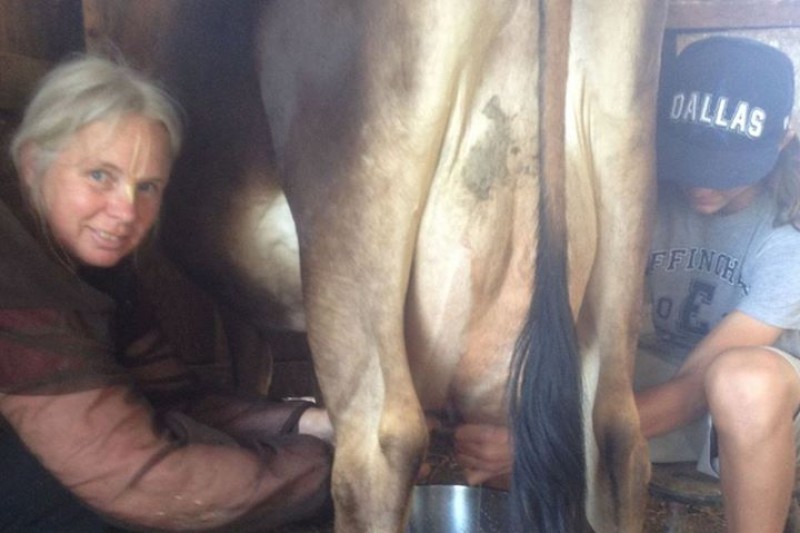
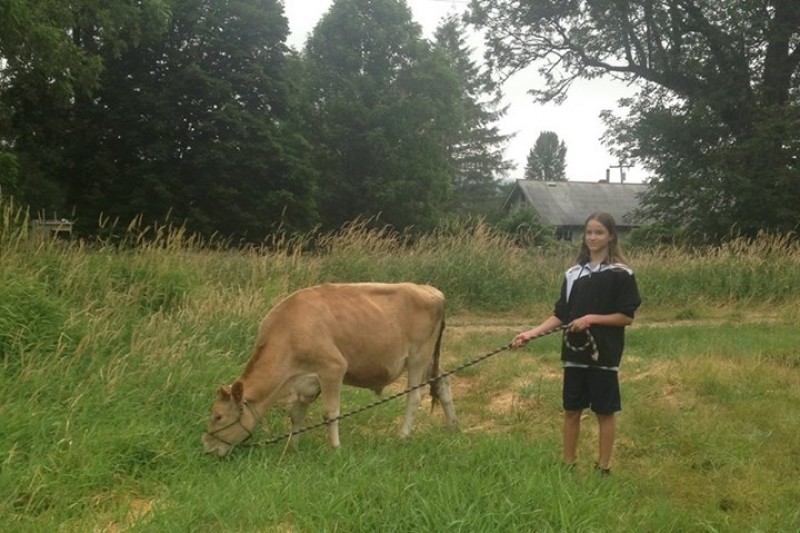
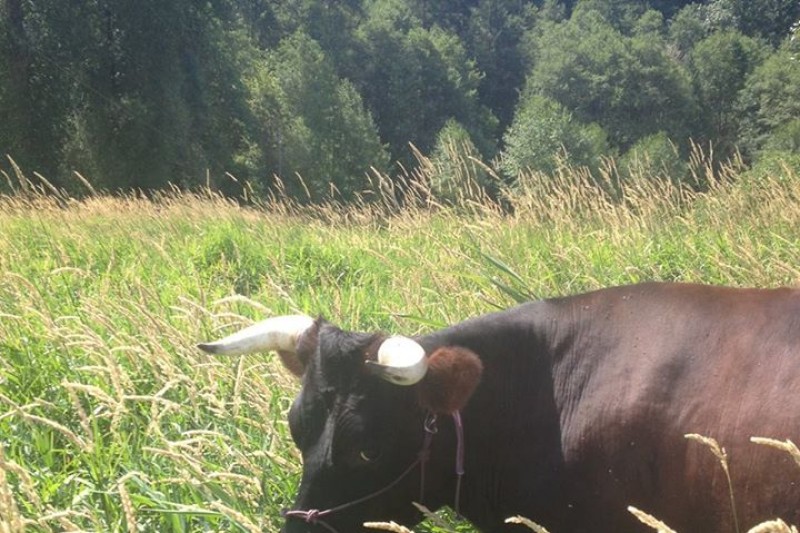
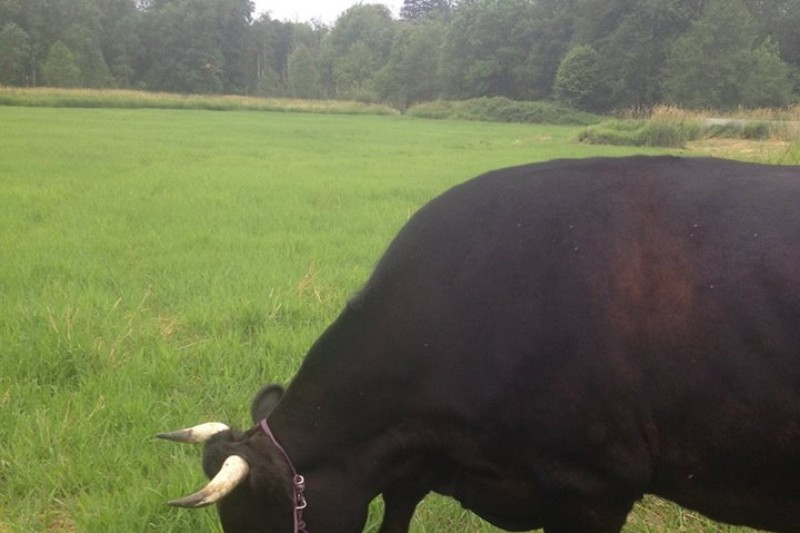
My husband Billy and I weren’t thinking about getting a cow. We didn’t want to make the time and commitment it takes to care for a cow and the herd that results from breeding her. Our involvement with cows came when my daughter started dating a vegan and Benjy, a Buddhist, wanted to know how we morally justified eating dairy products when we knew full well that the dairies were immoral places. Of course I explained that the cow benefits when I offer her milk/yogurt/butter to Krsna. Benjy wasn’t convinced, and occasionally made comments about the immorality of the commercial dairies that kept the uneasiness that I felt when buying dairy products at the forefront of my consciousness.
Then one day I got a phone call from Val, a friend who manages a local educational facility where they teach about pioneer life here in the Pacific Northwest. Val: “we need someone to milk our cow for 3 and half months while the museum is closed for the winter. Would you be interested?” She explained that they keep a cow so that people who come to the museum can have a “hands on” experience of milking, but usually sell the cow in the fall and buy a new one in the spring. Everyone working at the museum really liked Rain, their current cow, so they decided to try to keep her milking. With visions of myself under the cow in 20 degree weather, milking with frozen hands, I agreed with trepidation.
A few weeks later Rain was in our barn and we immediately fell in love with her. Rain was a jersey with a relaxed and affectionate personality but who also loved to bounce around and attack the manure cart when I was cleaning her stall. She loved nothing better than a good, thorough scratch on her brisket and withers, and would reciprocate by licking us with her scratchy tongue. I quickly found that I enjoyed the peaceful time spent milking her. Milking a cow is a connection to a timeless activity and my life developed a rhythm that helped me be conscious of Krsna’s perfect design. Sitting on a hand made wooden stool as the sun is setting on a mild evening, singing bhajans to my cow as I rhythmically milk her into a stainless steel bucket, is a pleasure that few people have experienced. I discovered that it took more time to process, store and distribute the milk and dairy products than it took to milk and care for the cow.
Through numerous “experiements” often resulting in what came to be called “happenstance cheese” (appropriate for soup and casseroles),I eventually developed a nice quality cheese that I could make without having a lot of special equipment. My cheese press was a colander with weights from Billy’s barbells. The cheese is aged in the refrigerator. Soon I was hosting cheese making classes and introducing many people to the concept of cow protection.
As spring approached, Rain’s milk production slowed to the point that I was concerned whether Rain would benefit the museum without being bred. They needed a cow that gave enough milk so many children per day could learn how to pinch off the milk that entered the teat and then squeeze that milk into a pail. Having a new calf would replenish her milk supply, so I trailered Rain to a neighboring dairy and introduced her to the young, mostly white Holstein bull on duty. The following winter she gave birth to a feisty black heifer, Dhana, and the museum agreed that since we took care of breeding Rain that the resulting calf would be ours.
We did the math regarding breeding cows and concluded that if we breed a cow every 2 years and the lifespan of a cow/bull is 20 years, we’d have to care for a herd of 10 cows/bulls to keep a milk cow. We had three acres, which was much too small a property to keep 10 cows, so we began to hope to be able to move further into the country where property is more affordable. When we first desired to move, it wasn’t possible to relocate right away due to Billy’s job, so we decided to learn everything we could about living self reliantly.
With the help of a group of like-minded people who formed a group called The Self Reliant Community, we studied bees, seed saving, grain crop raising, alternative energy, food preserving, composting, herbal medicine, making oil from oil seeds, alternative currencies, permaculture and much more. I eventually began training our first bull calf, Makani and found it very satisfying to work with him.
In 2010 the company that Billy worked for eliminated the division that Billy worked in so he joined the ranks of the unemployed. At that time we had 3 cows; Dhana, the matriarch; Makani, her brother and Dhana’s first calf, Lani Moo. We realized that it was time to find a property that was suitable for keeping cows. Several years earlier, Billy, while I was experimenting with using hypnosis in conjunction with astrology had an out-of-body experience where he felt himself to be an eagle flying through a beautiful valley. He had an overwhelming feeling that the valley he was seeing was a safe place, a sanctuary. After that experience, we’d sometimes go for day trip adventures, trying to find the valley. We strongly felt that the Morton/Randle area was near that valley and we’d look at satellite maps, trying to pinpoint the exact location.
One day I decided to go look for properties in the area we were attracted to. Since I intended to explore vacant properties, and generally be nosy, I decided to take a friend and leave Billy home. He is uncomfortable knocking on strangers’ doors, driving down deserted driveways and doesn’t like people to think he is lurking or loitering. Good thing, too. The friend I brought as a spotter saw a property that looked vacant. We drove into the driveway and could immediately see that it was abandoned. Knee high grass was growing around the buildings, there were no vehicles or personal things around and some of the windows were boarded up. There was no “for sale” sign, but there was a paper in one of the windows with a name and phone number in very small type on it. So we noted the address and the phone number and I went home to research the property.
Searching the county records, the owner turned out to be the Veterans Administration, making us surmise that the property had been in foreclosure. Additionally there were over 15,000 sq. ft of buildings including two barns a covered arena and other out buildings. The house was 1200 sq. ft with a garage. When I called the phone number, a realtor answered and said, yes, it was for sale with an asking price of $84,000. I told her we were very interested and then convinced Billy to make an offer. For us, buying the property with neither of us working a job was like diving off a cliff without being sure that there was water to dive into. We decided to sell our house and if it sold before the new property closed escrow, the equity would pay for the new property. It was 2011, and the real estate market was terrible, so the odds of selling our house quickly were poor. Although we didn’t like the idea of renting it out, that would be our only option if it didn’t sell right away. Amazingly we had an offer within days of putting it up for sale, and a contract in escrow within a week. Even more amazing was that we were able to purchase the new property without having a mortgage. It was the first time in my adult life that I was debt-free. Billy had had that freedom before, and being of an older generation, he was back in his comfort zone.
Our new property was perfect for doing a cow project: it had a large barn with stalls, a huge covered area to serve as a goshalla, plenty of storage for hay and the most wonderful soil for growing grass to feed our growing herd. In fact it turned out to be sub-irrigated, meaning that we didn’t have to water our garden, and that the grass continues to grow throughout the dry season. There was only one drawback, and it was a major one: there were only five acres, not enough to support the growing herd. We had noticed that at the northeast corner of the property there was a gate to a neighboring parcel that was safely fenced with no barbed wire and a nice 24‘ x 24‘ run-in barn. I don’t like barbed wire because if an animal gets a foot caught in it he’s likely to be seriously injured. Ranchers use it because it is effective and affordable, but they aren’t protecting cows, they’re exploiting them. As soon as we got hooked up to the internet, we intended to find the owner of that pasture and see if we could lease it.
A couple of days after we had moved in, our realtor stopped by and was very excited. “How many acres did you buy here?” Karen asked. Billy replied, “it is 5 acres.” “Wrong! You got another parcel, a 9 acre pasture with a barn! I just found out!”
We dug out the deed we received when the property was transferred, and sure enough, under the property description it listed: lot A and lot B, with lot B being about 9 acres. Of course we considered this surprise to be a gift from Krsna showing His support of our project. Right now the cows are out on that green pasture, lying under a cedar tree, chewing their cuds.
Cow protection is not the job for one older couple. Billy was 69 when we moved here three years ago, and I was 53. Our financial resources are meager, just Billy‘s social security. Fences need to be maintained, hay put in for the winter, buildings maintained, poop scooped, compost piles turned and money is needed to buy feed for the winter. As the herd began to grow, we needed help. A quarter mile down the road, at the base of Dog Mountain, a favorite hang gliding site, is a group of properties that was sub-divided years ago into mostly five acre parcels. Amazingly Krsna has allowed loyal Prabhupada devotees to buy three of the five properties, with each devotee purchasing a property that he was uniquely able to buy. One couple needed to have owner financing with a low down payment. One devotee needed to buy a foreclosure that was priced for a quick cash sale and one devotee needed a beautiful retreat. Now we have devotee neighbors to help us with the cows.
Although we didn’t intentionally start a cow protection project, we feel that the fact that Krsna gave us the opportunity, and we took it, that He is pleased with what we’re doing. Some devotees seem to keep cows more as props for fund-raising and I’m sorry, I think that’s wrong. Rescuing a few cows from slaughter doesn’t change the perception many people have that cows are here for our enjoyment, not as a part of God’s plan for how people should live. Living an ideal lifestyle means that cows are important community members who contribute by their labor and products. The only way to demonstrate that cow protection is satisfying, economically feasible and pleasing to God is to develop a community that genuinely lives that lifestyle. We didn’t have a community, but apparently Krsna is sending one to us. At the same time, the farmers around us to see how much we enjoy our bovine community members and hopefully their hearts are a little softened. We have plans to include them and the Deities (the very first Deities of ISKCON, the Panca Tattva ) in a local Loggers Jubilee parade. We are in need of new equipment such as harnesses, yokes, a cow shoeing stall, and milking paraphernalia.
So for those of you who secretly believe that it isn’t possible to protect cows, just look at what Krsna has done here to help an older, financially challenged couple try to fulfill Srila Prabhupada’s vision.




Organizer and beneficiary
Hanuman Das
Organizer
Cispus, WA
Anuttama Devi Dasi
Beneficiary